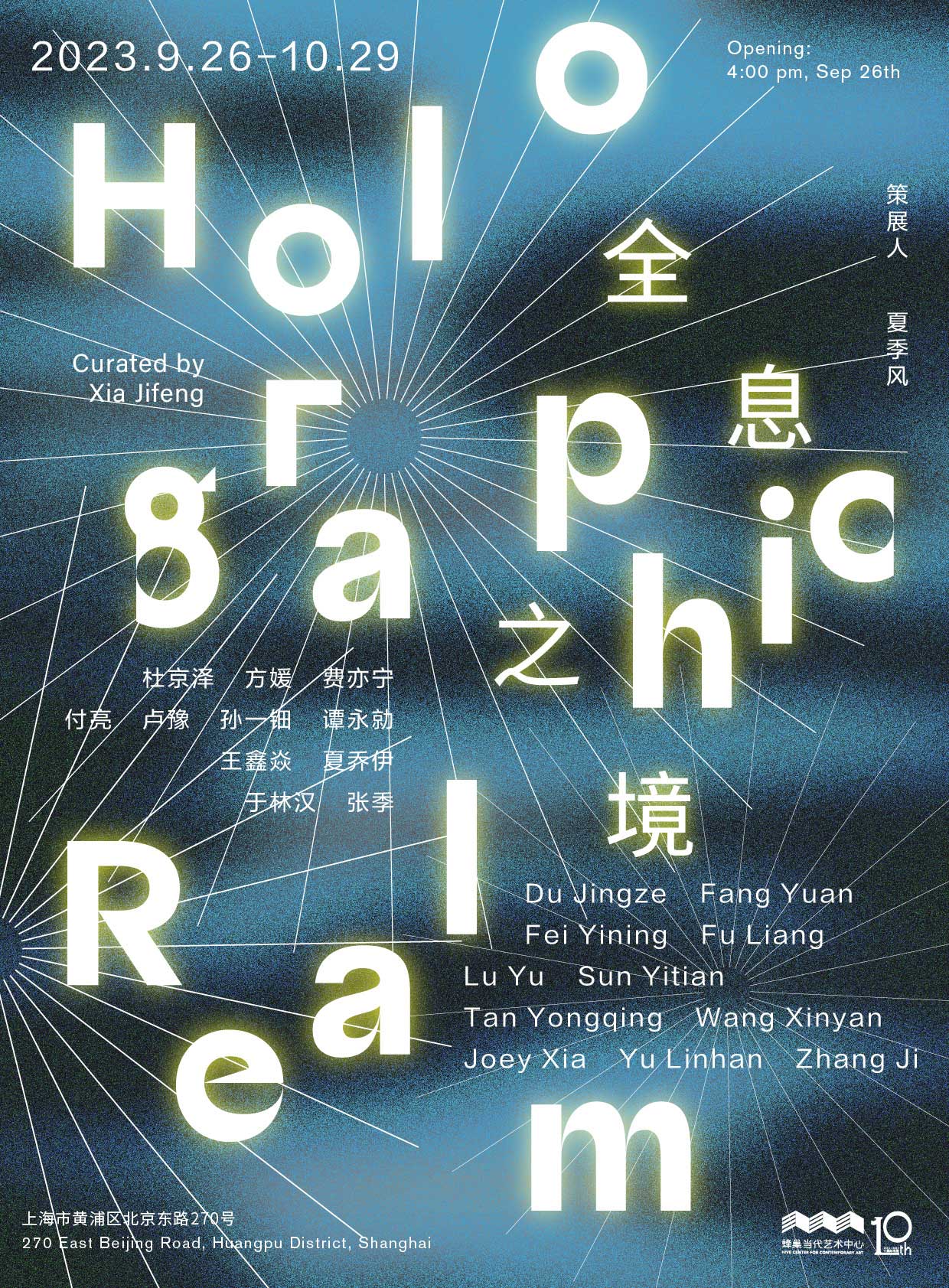展期 Period:
2023.9.26—2023.10.29
艺术家 Artist:
杜京泽 Du Jingze、方媛 Fang Yuan、费亦宁 Fei Yining、付亮 Fu Liang、卢豫 Lu Yu、孙一钿 Sun Yitian、谭永勍 Tan Yongqing、王鑫焱 Wang Xinyan、夏乔伊 Joey Xia、于林汉 Yu Linhan、张季 Zhang Ji
策展人 Curator:
地点 Venue:
蜂巢当代艺术中心 Hive Center for Contemporary Art(上海)
新闻稿 Press Release:
蜂巢当代艺术中心荣幸地宣布,在继“80一代”群体为主的“璀璨的轮廓”群展后,推出落户于上海外滩开幕三序曲中的第三篇章,以杜京泽、方媛、费亦宁、付亮、卢豫、孙一钿、谭永勍、王鑫焱、夏乔伊、于林汉、张季等11位“90一代”代表性艺术家组成的“全息之境”群展。本次展览由蜂巢当代艺术中心创始人夏季风策划。相较于在破碎与错位的历史时空之中完成自我建构的70、80后艺术家,“90一代”的道路显得异常清晰而又明确,开源式的全球信息及其影响下艺术家群体所完成的自我身份的编织与认同,让“90一代”自进入行业视野后便异常夺目,蜂巢当代艺术中心试借此次群展,呈现全球视角下“90一代”亚裔艺术家的群像,从一个更为宏观与立体的视角观察这一代艺术家的生态。
“全息”一词,取自人们熟识的“全息摄影”概念,意即对物体光学信息的解码与重组,用作此次展览的标题,意在喻指成长于“全球化”甜蜜期的“90一代”所获的难能可贵的成长与认知窗口期,在这里,他们获得了前所未有的、立体而又无边界限制的自我建筑空间,以及超越原生身份限制进而基于自我认知去参与全球性讨论的合法性。他们如世界公民般穿行于各个文化,至于所叠赋的各种文化与立场,则像是在不同的票箱当中投下的公民选票。然而,正当我们试图以简单的进步论去看待这一代艺术家,并企图以此作出一系列顺理成章的推论时,周遭世界的急剧变化以及全球意识形态的偏转,无不向我们揭示世界的流动现实,在警醒我们不要妄自对历史作出单向空间般的理想主义判断的同时,也让我们意识到这一代艺术家真正的可贵之处与历史存留的重要性。全球化概念不再一往无前,各个文化区域都在进行基于自身利益和立场的转变。刚刚筑起的立体的“全息”语境即将面对折叠、碾平甚至是揉碎,作为艺术工作者,不可能不对正在或即将发生的变化作出反应,如此种种,使得此次基于全球化与逆全球化拐点时空语境之下,针对亚裔艺术家创作生态的展览,更像是离“境”前的一番陈辞,而非一次归纳式的陈述。
成长于相同时代背景之下的“90一代”,在艺术创作中暴露出某些共性,并形成了一系列显著的视觉特质。例如,无论何种媒介,他们都可以坦然地将观看托付于二次图像的传播,由此,现场肉眼体验不再是在考虑观看时的第一顺位。他们获准观众透过电子荧屏审视作品,接受大小缩放、快速划切等与现代观看方式匹配的收看方法,并为观众预设了某种观看的逻辑更或说标准。此外,他们还将艺术家身份的设定与搭建视作艺术创作的重要组成部分。前置自身定位的艺术生态意识,在为他们寻找高效释放平台提供便利的同时,也为观看者们提供了更为准确的解读切口。在我看来,如此种种艺术创作者心态上的变化及其对行业结构性的全新理解,正是源于“全息”的成长路径所消弭的信息差、缝合的文化性差异以及对于现代传播学的信从。“90一代”的故事才刚刚开始,在对以上既成事实的反思与批判性讨论之后,不得不让我们好奇,这些即将出入于“全息之境”的青年艺术家们,在更早更完善策划好自己的艺术家身份的当下与未来,是否也有更为立体的方式去面对与回应不可预知的历史流变。
Hive Center for Contemporary Art is delighted to present the final chapter of the trilogy opening exhibition in our space at the Bund in Shanghai. Following Sihoulette of Splendors, which focused on the post-80s generation of artists, this group exhibition, Holographic Realm, features 11 prominent artists of the post-90s generation, including Du Jingze, Fang Yuan, Fei Yining, Fu Liang, Lu Yu, Sun Yitian, Tan Yongqing, Wang Xinyan, Joey Xia, Yu Linhan, and Zhang Ji. This exhibition is curated by Hive’s founder, Xia Jifeng. While the construction of identity for artists of the post-70s and 80s occurred in a disrupted and dislocated historical context, for the post-90s generation, the journey becomes much more distinct and explicit. The accessibility of global information and its impact on the fabrication and establishment of the artists’ self-identity have made the post-90s generation remarkably outstanding since it first entered the industry’s sight. Through this group exhibition, Hive attempts to present a collective portrait of the post-90s generation of artists of Chinese descent from a global perspective and to observe the ecology of this generation in a comprehensive and inclusive approach.
The exhibition title draws from the familiar concept of ‘holography’, which refers to the decoding and reconstruction of optical information. It is intended to signify the precious window of growth and awareness for the post-90s generation growing up in the honeymoon phase of globalisation, where they have acquired an unprecedented, comprehensive, and unconfined space for personal development, and the legitimacy to participate in global discussion upon their self-awareness, beyond the limitations of their original identities. They travel through diverse cultures like citizens of the world, and the accumulation of cultures and perspectives casts their ballots in different votings. Yet, just as we are trying to examine this generation of artists by the simple theory of progression in an attempt to reach a series of reasonable conclusions, the drastic changes in the world around us and the shift in global ideologies reveal to us the fluid reality of the world, warning us of the importance of avoiding idealistic judgments of history as a unidirectional scope, while simultaneously reminding us of the merit of this generation of artists and the significance of the preservation of history. The course of globalisation is no longer unrelenting, and all regions of culture are witnessing changes in their own advantages and positions. The three-dimensional ‘holographic’ discourse that has just been established is to be folded, flattened, and even crumbled; it is impossible for an art professional not to respond to the changes that are happening or imminent. In this way, this exhibition, addressing the creative ecology of artists of Chinese descent in the current context between the turning point of globalisation and counter-globalisation, becomes a declaration before the departure from the ‘realm’ rather than a generalised statement.
Growing up in the same historical background, the post-90s generation shares certain characteristics in their artistic practices and has developed a series of distinctive visual features. For example, they are open to delegating viewing to the secondary transmission of images, regardless of the medium, whereby the firsthand visual experience is no longer the priority when it comes to viewing. They allow the viewer to examine the work through the electronic screen, embrace viewing modes compatible with contemporary methods, such as zooming, scrolling, or swiping, and predetermine a certain logic or standard of viewing for the viewer. Besides, they also consider the definition and formation of their identity as artists to be a significant part of their practice. The art-ecological consciousness that emphasises their disposition facilitates their pursuit of an efficient platform for expression while offering the viewer a more precise perspective. It seems to me that these changes in the mentality of artists and their fresh understanding of the structural nature of the industry originate from the ‘holographic’ journey of growth, which has removed the information gap, bridged cultural differences, and convinced us of contemporary communication. The narration of the post-90s generation has just begun. After reflecting on and critically discussing the above fait accompli, we have to wonder if these young artists, who are about to venture into the ‘holographic realm’, might have a more sophisticated approach to confronting and responding to the unpredictable flux of history in the present and future, where they have cultivated their identity as artists earlier and more thoroughly.

